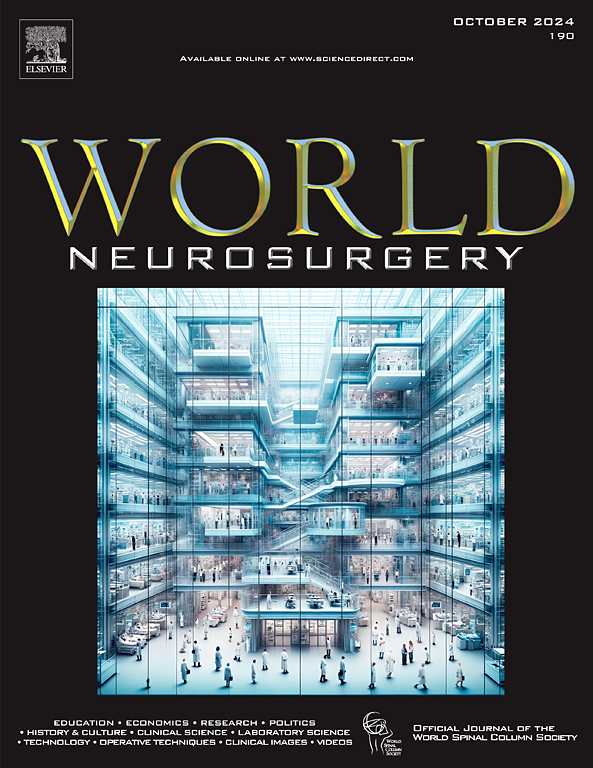Surgical Management of Symptomatic Recurrent/Progressive Craniopharyngioma: Is There a Gold-Standard Approach?
IF 1.9
4区 医学
Q3 CLINICAL NEUROLOGY
引用次数: 0
Abstract
Background
The standard treatment for craniopharyngiomas (CPs) involves either initial gross total resection or subtotal resection with adjuvant radiotherapy. However, there is no consensus regarding the management of recurrent cases. We reviewed a series of patients with CP to evaluate the characteristics of patients with recurrent/progressing CP.
Methods
We retrospectively reviewed 31 patients with biopsy-proven recurrent/progressed CP who were initially operated on at our clinic from 2015 to 2023. Demographic and clinical data, including age, sex, tumor localization, lesion size and features, radiologic findings, and endocrine, neurologic, and ophthalmologic issues, were compared between those with and without recurrence.
Results
Fifteen out of 31 patients (48.4%) underwent transnasal/transsphenoidal endoscopic surgery; the remaining 16 underwent microscopic transcranial or neuroendoscopic surgery. After treatment, recurrence, and events (any medical condition related to the patient's current condition other than recurrence) were observed in 48.4% and 32.3% of the cases, respectively. There were no statistically significant disparities between patients with and without recurrence in terms of age, tumor dimensions, tumor localization, gender distribution, surgical modality, or the presence of calcifications or hydrocephalus (P > 0.05). The highest and lowest overall survival was 25 years and 6 months, respectively.
Conclusions
The management of recurrent CP is too complicated to fit into a standard treatment algorithm. Therefore, surgical treatment for these patients should be individualized and planned according to patient symptoms and radiologic findings, which is presumably a more versatile, efficient, and safe approach for recurrent CPs.
症状性复发性/进展性颅咽管瘤的手术治疗:有没有金标准方法?
目的:颅咽管瘤(CPs)的标准治疗方法包括初次大体全切除或次全切除并辅助放疗。然而,对于复发病例的治疗尚未达成共识。我们回顾了一系列 CP 患者,以评估复发/进展期 CP 患者的特征:我们回顾性研究了 2015 年至 2023 年在本诊所接受初次手术的 31 例经活检证实的复发性/进展性 CP 患者。比较了复发和未复发患者的人口统计学和临床数据,包括年龄、性别、肿瘤定位、病灶大小和特征、放射学检查结果以及内分泌、神经和眼科问题:31例患者中有15例(48.4%)接受了经鼻/经蝶内窥镜手术,其余16例接受了显微经颅或神经内窥镜手术。治疗后,分别有48.4%和32.3%的病例观察到复发和事件(除复发外与患者当前病情相关的任何医疗状况)。在年龄、肿瘤尺寸、肿瘤定位、性别分布、手术方式、是否存在钙化或脑积水等方面,复发和未复发患者之间没有明显的统计学差异(P > 0.05)。最高和最低总生存期分别为25年和6个月:结论:复发性 CP 的治疗过于复杂,无法采用标准的治疗算法。因此,对这些患者的手术治疗应根据患者的症状和放射学检查结果进行个体化规划,这可能是治疗复发性 CP 的一种更加灵活、高效和安全的方法。
本文章由计算机程序翻译,如有差异,请以英文原文为准。
求助全文
约1分钟内获得全文
求助全文
来源期刊

World neurosurgery
CLINICAL NEUROLOGY-SURGERY
CiteScore
3.90
自引率
15.00%
发文量
1765
审稿时长
47 days
期刊介绍:
World Neurosurgery has an open access mirror journal World Neurosurgery: X, sharing the same aims and scope, editorial team, submission system and rigorous peer review.
The journal''s mission is to:
-To provide a first-class international forum and a 2-way conduit for dialogue that is relevant to neurosurgeons and providers who care for neurosurgery patients. The categories of the exchanged information include clinical and basic science, as well as global information that provide social, political, educational, economic, cultural or societal insights and knowledge that are of significance and relevance to worldwide neurosurgery patient care.
-To act as a primary intellectual catalyst for the stimulation of creativity, the creation of new knowledge, and the enhancement of quality neurosurgical care worldwide.
-To provide a forum for communication that enriches the lives of all neurosurgeons and their colleagues; and, in so doing, enriches the lives of their patients.
Topics to be addressed in World Neurosurgery include: EDUCATION, ECONOMICS, RESEARCH, POLITICS, HISTORY, CULTURE, CLINICAL SCIENCE, LABORATORY SCIENCE, TECHNOLOGY, OPERATIVE TECHNIQUES, CLINICAL IMAGES, VIDEOS
 求助内容:
求助内容: 应助结果提醒方式:
应助结果提醒方式:


